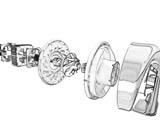Ease is good
Anne-Celine Jaeger asks why products are compromised by too many functions

Whether it’s the mobile trying to outperform the average laptop, or the remote with more buttons than an aeroplane cockpit, it appears design and technology have taken a wrong turn in recent years. Indeed, the ‘added feature’ concept has turned into such an epidemic, rather than making our lives easier it is only adding to the confusion. So much so, some designers are urging for a move towards simplicity.
John Maeda, associate professor of design and computation at Massachusetts Institute of Technology’s Media Lab, is a case in point. Having launched the Simplicity Design Workshop, an initiative that encourages designers to collaborate with researchers, Maeda is hoping to start a micro revolution, with simplicity as the driving force.
He says, ‘Technology and design work best when they are merged, but they got separated in the dotcom era. Simplicity is an endangered quality in the digital world.’ Maeda argues it’s time to break free from technology’s intimidating complexity. In the past 20 years, he suggests, we’ve gone from the simplicity of MacPaint to Photoshop. While the first fostered a creative explosion, the second gave birth to an industry of how-to books. ‘I just don’t see how adding extra speed, bigger screens and more input devices is making our lives better. Design has to take leadership again and it hasn’t had the opportunity for a long time,’ he says.
When brainstorming what it was that actually defined ‘simplicity’, the Design Workshop came up with some modern examples. It gave the Apple iPod a thumbs-up for its minimalist form and intuitive interface. It nominated Google for its straightforward search facility, and the Screwpull corkscrew for its mechanical elegance, suggesting that the key elements needed were aesthetic appeal, restraint and transparency.
Working towards a similar goal, James Dyson, chairman of Dyson, believes technology should be used to make things work better, not to show off. ‘Dyson develops technologies and designs that make products perform better. We’re not intent on just adding features to give consumers more apparent choice. How something works is so much more important than how it looks. But, unfortunately, the look of a product is what gets talked about most.’
In a world where Philippe Starck, designer of the amusing, but impractical Alessi Juicy Salif lemon squeezer, is a celebrity styling king, Dyson laments the fact that design is now all about name-dropping and label wearing. ‘The danger,’ he says, ‘is that the designer becomes little more than a creator of ineffectual ornaments – hardly in the spirit of Isambard Kingdom Brunel.’ Perhaps to blame, says Dyson, are marketing departments, forever demanding more features in order to outgun their rivals.
When Adam White, creative partner at Factory Design, asked mobile phone manufacturers if they could create a simple phone for the large body of people not interested in endless functions, he witnessed this rift between design and technology first-hand. Rather than applaud the idea, manufacturers told him it would cost them more to create a simple version, as technology was already too advanced.
Whether designing a lightweight seat for Concorde or the Remington 2xProtection hairdryer, White always tries to imagine how the consumer might use the product. Hence, it seems erroneous to him that we’re at a stage where manufacturing dictates form and function rather than the other way around. However, he says, ‘Products such as the iPod, that are easy to use, are sending out messages. There is definitely a trend towards simplifying technology.’
The move towards simplicity, it appears, is not limited to product design. Even in the fashion industry, designers are turning away from creating garments with a surplus of stylistic elements that have no function. Cathal McAteer, head of label Folk and fashion agency Macandi, has always worked with that philosophy in mind. He says, ‘Our clothes are simple and non-restrictive. We don’t cut into things or alter shapes. Folk is more about being comfortable.’
Whereas White and Dyson both put the consumer first, McAteer takes it one step further and visualises his friends during the creative process. Maeda, whose approach is similar to McAteer’s, says you don’t have to focus on simplicity to achieve it. He says, ‘If you keep your family in mind when designing; if you know what’s important to them, one of the things you’ll automatically end up with is simplicity.’
Luke Hawes, director at Priestman Goode, agrees there is no point creating products with superfluous functions, but believes desirability for an object outweighs all other criteria. He says, ‘We try to create products that people crave.’ And if that means designing a minimalist-looking product that sits perfectly with the overall branded vision, so be it. But for Hawes, simplicity is not necessarily the first step.
So what is the formula for creating good, simple design? ‘I hate to say it,’ says Maeda, ‘but I think designers should look to the past when conceiving new products. We’ve lost our history. Many young designers have never heard of Paul Rand – the father of graphic design – that’s like not knowing the teachings.’ Maeda believes we’re witnessing a loss of history in all disciplines, not just design. And yet, he argues, it’s this sense of history that provides the link to the tenets of human behaviour and what we value in our interactions (certainly not a mobile that requires a dozen commands before it can make a call). ‘It’s about trust,’ says Maeda, ‘basic trust in someone or something.’
-
Post a comment



